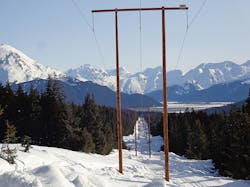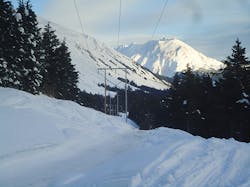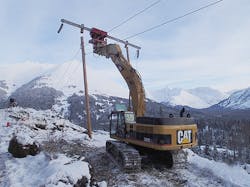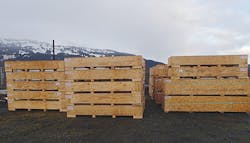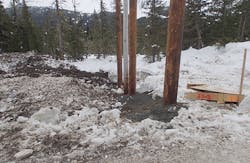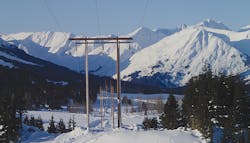Everything in Alaska is more extreme: the wildlife, the weather and the challenges of building transmission lines. During the 2012-2013 winter, Chugach Electric Association rebuilt a 115-kV wood-pole transmission line. It was the first time the cooperative had used pre-kitted hardware and it worked very well. While most utilities do not have to work under such extreme conditions, Chugach found the advantages of having all the hardware for each pole in one package would benefit any project.
A Critical Line
Chugach is a member-owned cooperative headquartered in Anchorage, Alaska, U.S., with generation, transmission and distribution assets spread across a broad service territory. Its 115-kV Quartz Creek transmission line connects two hydroelectric dams on the Kenai Peninsula to customers throughout the Railbelt, an area containing Alaska’s railroad, its most populous cities and about three-fourths of the state’s population. Chugach rebuilt a 15-mile (24-km) section of the 90-mile (145-km) line in an area where snowstorms regularly drop a couple feet of snow at a time throughout the winter.
The Quartz Creek line was originally built in 1962 to connect Chugach’s Cooper Lake Hydroelectric project to customers in Anchorage. In 1991, the state of Alaska brought the substantially larger Bradley Lake Hydro project on-line. Utilities that take power from Bradley Lake depend on Chugach’s transmission line to deliver their shares of the project.
The Quartz Creek line is critical because it is the only transmission line connecting the Kenai Peninsula and the Anchorage area. Furthermore, power from the two projects on the Kenai is among the cheapest in the Railbelt.
Aging Structures
The Quartz Creek line desperately needed an upgrade. Its structures were more than 50 years old, so Chugach had been keeping an eye on the structural integrity. In 2007, the cooperative performed a detailed helicopter survey that revealed some deterioration of the wood H-frame towers. During the summer of 2008, crews worked their way down the right-of-way and tested the arms and poles; about 50% of the poles surveyed showed signs of rot.
Timing is everything. The cooperative wanted to replace the towers while they were still able to withstand winter storms, that is, before they started failing. It is worth noting the towers, although in need of repair, were still intact. This was proven during the very bad winter of 2011-2012, before work had started on the line. In total, more than 11 ft (3.3 m) of snow had fallen in Anchorage, but more snow fell in the mountains where a snowpack 20-ft (6-m) deep is common.
During that winter, structures on the Quartz Creek line were bent over like a fishing rod with a king salmon on the end. But, despite the deterioration, the structures stayed intact. It is a testimony to the quality of wood used originally for the structures — clear, good-grained, old-growth wood. That winter, Chugach lost one arm and one pole. That was it. Nevertheless, the deteriorating poles had to go.
Careful Planning
Knowing a substantial amount of work needed to be done, the cooperative divided repairs into two classifications: immediate and long term. In 2008 and 2009, Chugach operations personnel completed several critical jobs to ensure short-term reliability. During that same period, the planning and engineering departments identified and prioritized the line sections in the worst shape.
The first goal was to replace the most critical 15-mile section, which happened to cross through the toughest terrain. The overall 90-mile line crosses a mountain range, bends around a body of water, jumps back through the Chugach Mountains and then finds its way to Anchorage. The critical 15-mile section has about 110 wood towers.
In Alaska, public funding is available, at times, to help mitigate the cost of rebuilding critical electrical infrastructure, but the process to obtain public funding is indeterminate. In some cases, funding can be obtained in a calendar year. In this case, funding for the Quartz Creek rebuild was a two-year effort. Chugach received authorization for the money in July 2011 and immediately began the permitting process, which also can take a long time.
The cooperative knew the work would have to be performed during the winter months when snow roads could be built. Snow roads mitigate environmental impact and provide access. Timing was just one of the issues Chugach had to consider in the Quartz Creek rebuild project.
It was clear from the beginning that the rebuild was going to be challenging. There are three things to think about before beginning any line project: design, permitting and materials delivery. In this case, the design was not complicated and the permitting work was started early. But, make no mistake, supply chain logistics are always a challenge in Alaska.
Permitting and Recreation
Overall, permitting took about a year. The Alaska Department of Natural Resources controls a little more than one-third of the land; the U.S. Forest Service controls the rest. Most of the right-of-way was in an environmentally sensitive area, but the main challenge was recreational use. The middle 5 miles (8 km) of the line section are in one of the prime winter recreation areas for Southcentral Alaska: one side of the road is used by snowmobiles and the other side offers exceptional backcountry skiing. A lot of recreational users would be out and about in the area where Chugach needed to be working on the rebuild, so the cooperative had to respond to stakeholders and bring them into the process.
The contractor for the rebuild, Alcan Electrical & Engineering Inc., worked with the various recreational user groups, and a large portion of the project’s success can be tied directly to Alcan’s communication and outreach efforts.
Thoughtful Design
The lengthy permit process provided ample time for Chugach to put some thought into the new tower designs. The cooperative worked with local design firm Dryden & LaRue Inc. to address three specific issues:
1. The transmission line needed to be rebuilt and insulated for 230 kV, because a long-term planning study had called for it to be at 230 kV instead of the existing 115 kV.
2. In light of recent record snowfalls, some towers needed to be significantly increased in height. The new designs added between 8 ft and 20 ft (2.4 m and 6.1 m) to the poles, where needed, to provide increased clearances during heavy snowfalls. To illustrate, the average height of the structures in that 15-mile line section before construction was 65 ft (20 m) and after construction is now approximately 95 ft (29 m).
3. To limit the structure weight, about one-third of the wood structures needed to be replaced with steel.
Chugach wanted to ensure this project could be built using helicopters, if necessary. If there is not enough snow on the ground to build snow roads to the site, helicopters are used to deliver materials. The heaviest wood poles weighed as much as 10,000 lb (4536 kg), but in these cases, steel poles were substituted. Because of the substantial snowfall during the winter of 2012-2013, Alcan did not need to use a helicopter and was able to build snow roads and drag in the materials.
With permitting and designs complete, crews started clearing and staging on Nov. 6, 2012, and re-energized the line on April 16, 2013.
Advantages of Kitting
Lastly, the cooperative addressed materials delivery. Chugach divided the project into four purchases: conductor, wood poles, steel poles and line hardware. The first three purchase orders were commodities and arrived in three big shipments. For example, the 168 wood poles arrived by rail close to the site, were trucked to the work zone and staged along the way. The fourth purchase order was different.
It would simplify things greatly if all the other parts and pieces could be delivered in one shipment, already kitted. This included specific insulators and hardware, and, in some cases, hardware manufactured especially for the project. The cooperative wanted to find a way to get all the parts delivered conveniently and efficiently.
An engineer remembered seeing a few magazine articles about pre-kitted hardware that seemed like a good idea. It turns out this approach is not usually used on projects as technically simple as the one being planned. And there was some skepticism at the cooperative, as well, because no one had done anything like it before.
But pre-kitting would solve several problems, so the cooperative talked to several suppliers and wholesalers who do kitting. Most of them did not think this project was big enough to bother with kitting; Hubbell Power Systems was the only manufacturer interested. Chugach put together a specification to containerize all the pieces — the insulators, hanging hardware and connecting hardware — needed for each structure.
The spec required all parts be shipped in sealed, durable boxes that would hold up to extreme weather. Hubbell Power Systems — through its suppliers in Anchorage, Potelcom and WESCO — offered its TowerPak kitted solution. The cooperative placed the order in October 2012 for delivery by the end of the year. Despite a big winter storm hitting the East Coast, everything was delivered on time.
Problems Solved
Pre-kitting solved several problems, beginning with simplifying deliveries. Shipping things from anywhere to Alaska is an opportunity for something to get lost. It happens regularly. Parts get sent to the wrong destination, such as Alabama (AL) instead of Alaska (AK). Or, the shipment is late and misses the barge in Seattle, Washington, U.S. Or, the shipper has never come this way and is not familiar with road conditions, permitting requirements and clearances. To minimize the risks, Chugach wanted to deal with one supplier that could put
everything together in one consolidated shipment.
The second problem pre-kitting solved was holding up to the weather. This project was completed in an Alaskan mountain pass in the middle of winter, where a typical winter storm drops at least 1 ft to 2 ft (0.3 m to 0.6 m) of snow on the ground. Boxes of hardware can get buried and be difficult to find in a snowbank. Also, anything delivered in a cardboard box is at risk because they get wet and fall apart. Once a part is out of whatever container it came in, it is as good as gone. TowerPak solved this problem as the parts are packaged in wire-bound, weather-resistant crates. Chugach received 112 TowerPaks, one crate per tower and a few extra. All arrived as ordered and none disappeared in the snow.
Shawn Wendling ([email protected]) is a senior project engineer in the transmission and substation engineering department at Chugach Electric Association Inc. For the last 13 years, he has worked on the design and construction of new transmission lines. In addition, Wendling has managed critical structure repair projects under adverse conditions and in remote locations. He has a bachelor’s degree in mechanical engineering technology and a master’s degree in project management.
Mentioned in this article:
Alcan Electrical & Engineering Inc. | www.alcanelectric.com
Chugach Electric | www.chugachelectric.com
Dryden & LaRue Inc. | www.drydenlarue.com
Hubbell Power Systems | www.hubbellpowersystems.com
Potelcom | www.potelcom.com
WESCO | www.wesco.com

